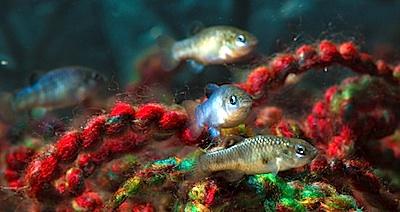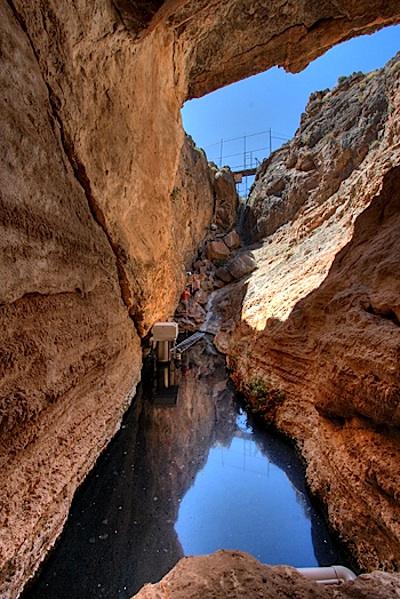
Devils Hole pupfish in the Ash Meadows Fish Conservation Facility in Nevada's Amargosa Valley. These individuals hatched from eggs removed from Devils Hole in November 2013. Males with the blue tint court the olive colored females. Eggs are deposited on the yarn "spawning mops."/USFWS
With a small, isolated population of pupfish at Death Valley National Park facing a 30 percent chance of going extinct by 2034, a University of California scientist is suggesting a more aggressive captive-breeding program for the fish.
The Devils Hole pupfish came close to extinction in the spring of 2013 when its population was estimated at an all-time low of 35. While attempts at captive breeding have met with so-so results, Steven Beissinger, a professor of environmental science, policy and management at UC Berkeley, believes better results could be had if biologists transferred pupfish eggs, not adults, from Devils Hole to the captive-breeding facility at the Ash Meadows Fish Conservation Facility less than a mile from the spring that holds the wild population.
The Devil's Hole pupfish is something of an aquatic wonder, managing to live in a relatively small hot spring, one that denies them the ability to migrate up or down stream. Rather, they congregate in the spring, rising up to a small shelf of rock just beneath the water's surface both to feed and breed. While 40 acres around the spring, which isn't actually within the formal borders of Death Valley National Park but rather off to the east, were set aside in 1952 to protect the hot spring and its inhabitants, a fight over groundwater led to a 1976 Supreme Court ruling that the Park Service was entitled to a specific water right to maintain the hot spring for the fish.
Devils Hole pupfish populations numbered about 400-500 individuals until the late 1960s, when the water level in the pool dropped in response to pumping of nearby irrigation wells, according to the USGS.
As described in a UC Berkeley news release, the Devils Hole pupfish (Cyprinodon diabolis) is "considered the world's rarest fish, with one of the smallest geographic ranges of any wild vertebrate..."
According to the university, "previous attempts to establish refuge populations of pupfish have not fared well, either because the transplanted fish did not survive or because they cross-bred with other species of pupfish."
A risk analysis on the pupfish population by Professor Beissinger concluded that it is "better to transfer pupfish eggs to a captive breeding facility rather than adults, and that it was preferable to transfer fish in the fall, when the population tends to be larger, rather than in the spring."
Additionally, the professor found that "moving more than six adults per year for three consecutive years rapidly increases the risk of extinction. The results ... showed that the wild pupfish faces a 28 to 32 percent risk of extinction over the next 20 years."

Devils Hole/NPS
'The study really puts out more empirically the risk of extinction for this fish,' said Kevin Wilson, an aquatic ecologist at Death Valley National Park who is working on the recovery of the pupfish. 'These findings are providing us with very good tools for our toolbox.'
Geologists estimate that the cavern in which the wild pupfish live is at least 426 feet deep and was formed more than 500,000 years ago. "The pupfish are believed to somehow have gained access to the site less than 50,000 years ago when a roof of the cavern collapsed, possibly due to an earthquake, exposing the cavern and its water to the ground surface," the university release said. "The oxygen-poor water in Devils Hole stays a toasty 92-93 degrees Fahrenheit, around the upper limits of temperature tolerated by most fish."
Professor Beissinger also "calculated that if the wild Devils Hole pupfish numbers become small enough, it may be necessary to remove the entire population into a captive breeding program, an extreme measure he called a 'California condor moment' because such a controversial action was used to rescue the condor from extinction in 1986.
He noted that, unlike the slow-reproducing condor that does not breed until 5 or 6 years of age, the Devils Hole pupfish has the potential for faster population growth because it matures quickly and can reproduce multiple times in its first year of life.
'Somehow, this handsome little fish has heroically persisted in the harsh desert environment through thousands of years of drastic climate warming and droughts,' said the professor. 'Should the human condition ever arrive at this point after another century of increasing carbon dioxide emissions and climate warming, we may need someone to help us out of our hole.'



Add comment